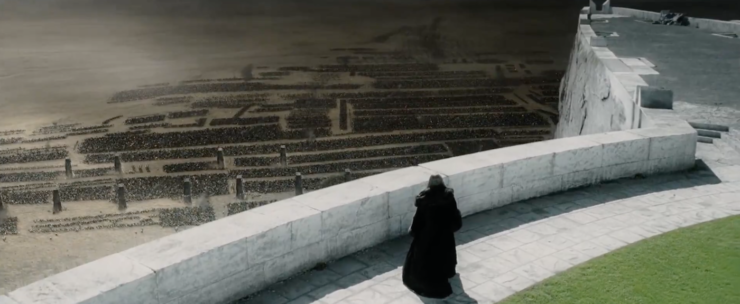The Siege of Gondor is one of the finest chapters in The Return of the King. Lush but taut, action-packed but psychologically precise, full of well-crafted tension and sentence-level heavy-lifting, it’s a master-class in the art of writing war.
So adapting it faithfully for the screen is no small feat. With so many moving parts, Peter Jackson had his work cut out for him when filming the battle for Minas Tirith. The different requirements of the medium mean that a lot of things end up getting changed or even lost in translation.
For a historical take on the scene, look no further than Bret Devereaux. A professional military historian specializing in the “Roman army of the Middle and Late Republic,” Devereaux runs a blog called “A Collection of Unmitigated Pedantry,” where he analyzes the historical accuracy of battle scenes and details in popular culture. (Like armor penetration myths and what a post-battle battlefield really looks like.) Back in May, he published an excellent six-part deep-dive into Jackson’s version of the Siege of Gondor, looking at everything from orc-army logistics to historical precedents for war elephants to troll physics (no, seriously). You really should drop what you’re doing and go read it right now (Part I, II, III, IV, V, VI), but to entice you, here are some of the highlights.
- Peter Jackson’s huge orc army? It’s way too big to even get to Minas Tirith all in the same day, even in the tightly packed columns we see depicted. (Especially in the tightly packed columns we see, in fact!)
- The Beacons of Gondor are 100% real, and a version was used by the Byzantine Empire in the 9th century!
- The Pelennor Steppe isn’t supposed to be just be a massive field, but should be dotted with fields, farms, trees, rocks, and small towns.
- The rectangular Tetris-esque orc formations outside Minas Tirith take extensive pre-planning to pull off, even if they’re only utilized for a display of intimidation, and their presence in the movie is most likely inspired by Nazi propaganda.
- Denethor is a far more active and shrewd defensive battle commander in the books, and is arguably the reason Minas Tirith survives up to the arrival of the Rohirrim.
- The films largely get armor and weaponry correct (with the exception of the shield Eowyn uses), even when something looks too fanciful (like the orcs’ spears).
- War elephants are real, but also surprisingly easy to defend against.
- The Lord of the Nazgûl’s super-cool mace/morning-star? It’s not a mace/morning-star at all, but a flail. And flails are very controversial, historically. They might not…have ever existed for use on a battlefield?
That’s not even a tenth of what Devereaux unveils. The historian explains all of this in the conclusion of his compelling series, but it should be noted that by no means is he saying the movie is bad while the book is good:
I actually think that Peter Jackson’s Lord of the Rings must stand as both one of the most difficult and one of the most successful adaptations in film history. Many of the film’s shortcomings in portraying a sense of battlefield realism have more to do with the constrains of the medium. Film is an incredible powerful medium, after all, but also a very limited one. Time is very limited and everything in a film must be compressed. Given those limitations, Jackson’s effort is nothing short of marvelous, even if it doesn’t always capture the depth and nuance of the books.
For more break-downs of high fantasy battle scenes from a military historian’s perspective, check out Devereaux’s two-parter on the “Loot Train Battle” from Game of Thrones season 7 episode 4, “The Spoils of War” and his one-off on that Dothraki charge from GoT season 8 episode 3, “The Long Night.” (Stay tuned for a complete look at the Battle of Winterfell some time in the future, which he calls “a train wreck.” We can’t wait.)
Meanwhile, if that whole section about elephantry caught your eye, you might want to check out his three-part series on War Elephants (Part I: Battle Pachyderms, Part II: Elephants against Wolves, and Part III: Elephant Memories). And if you’re a world-builder, Devereaux has conveniently collected all of the relevant pieces in one place.
Honestly, you should just head over to the whole blog, where more long-form goodies (like this one about the position of main gun batteries in Battlestar Galactica or this one about the effectiveness of arrow fire) await.










